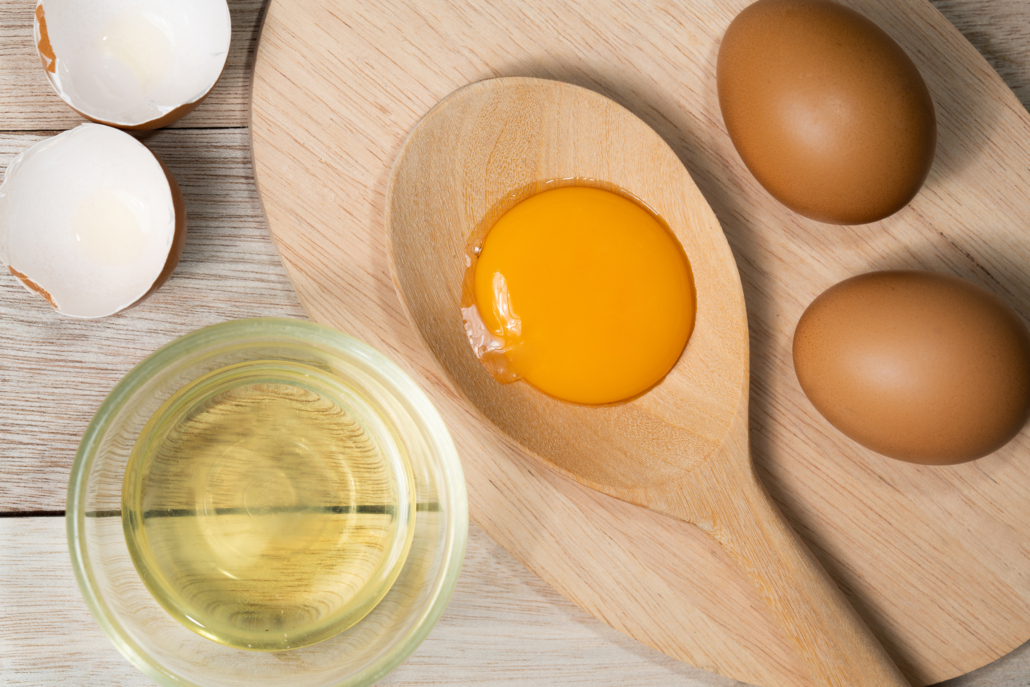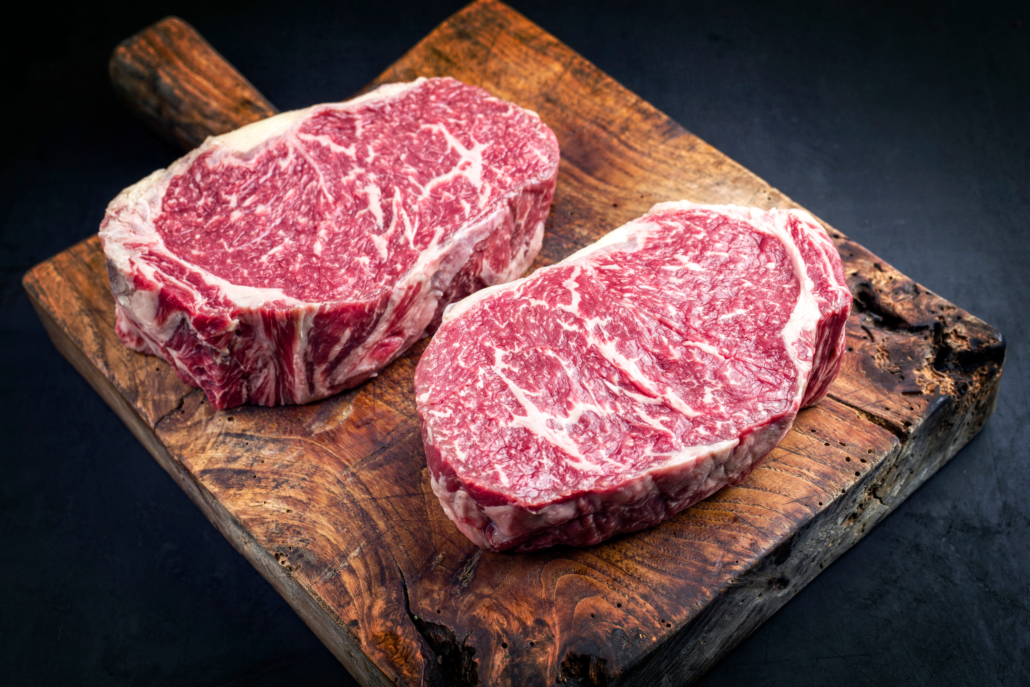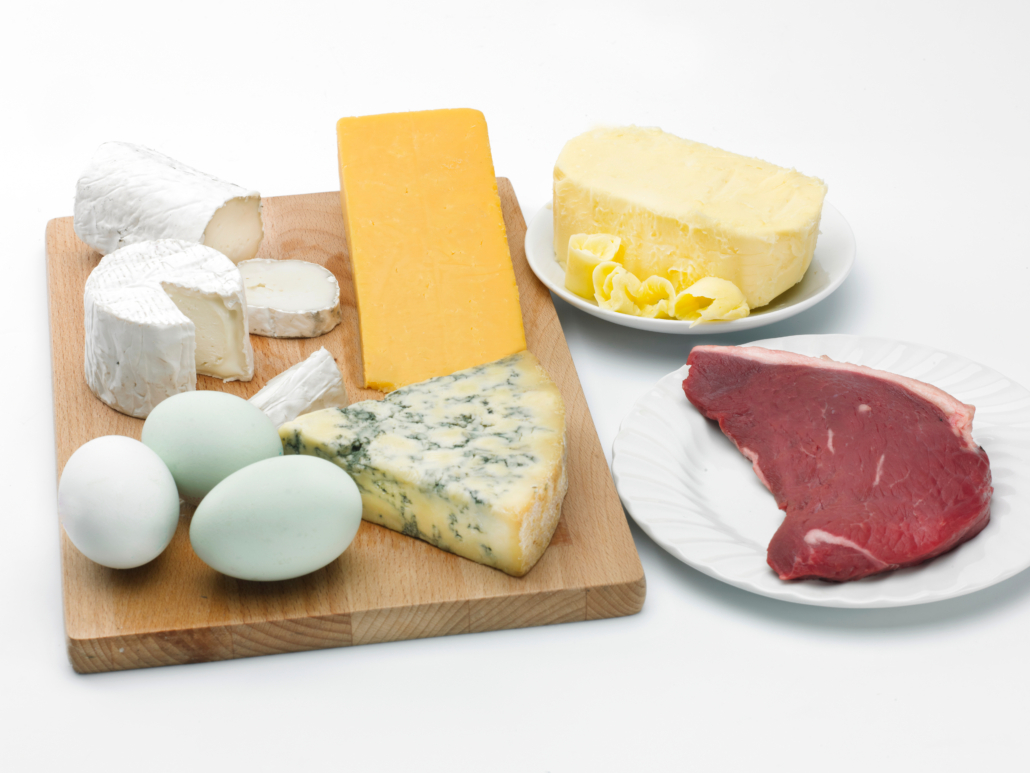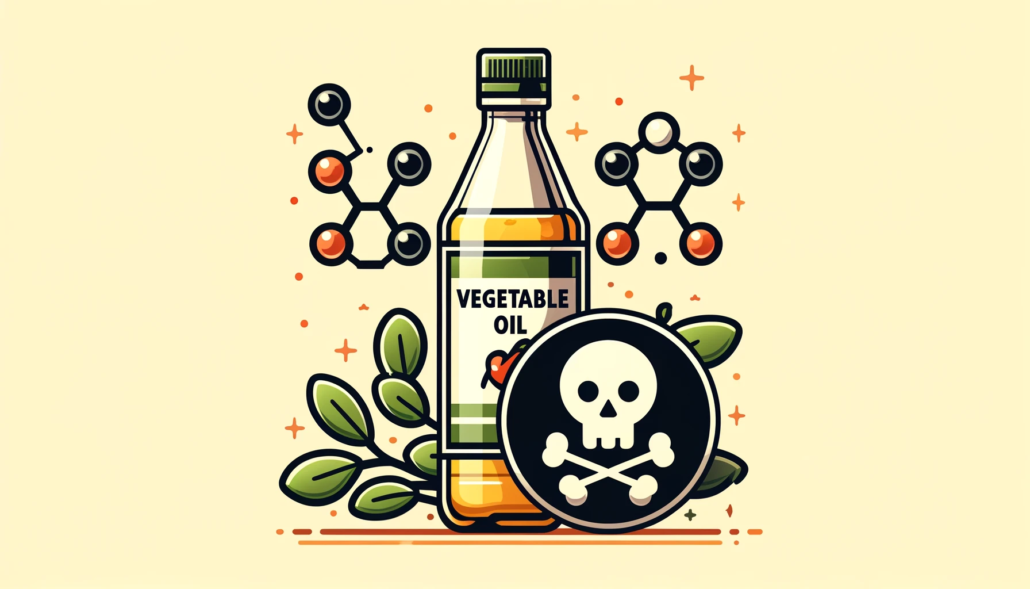We include products in articles we think are useful for our readers. If you buy products or services through links on our website, we may earn a small commission.
Low-Lectin and Lectin-Free Foods
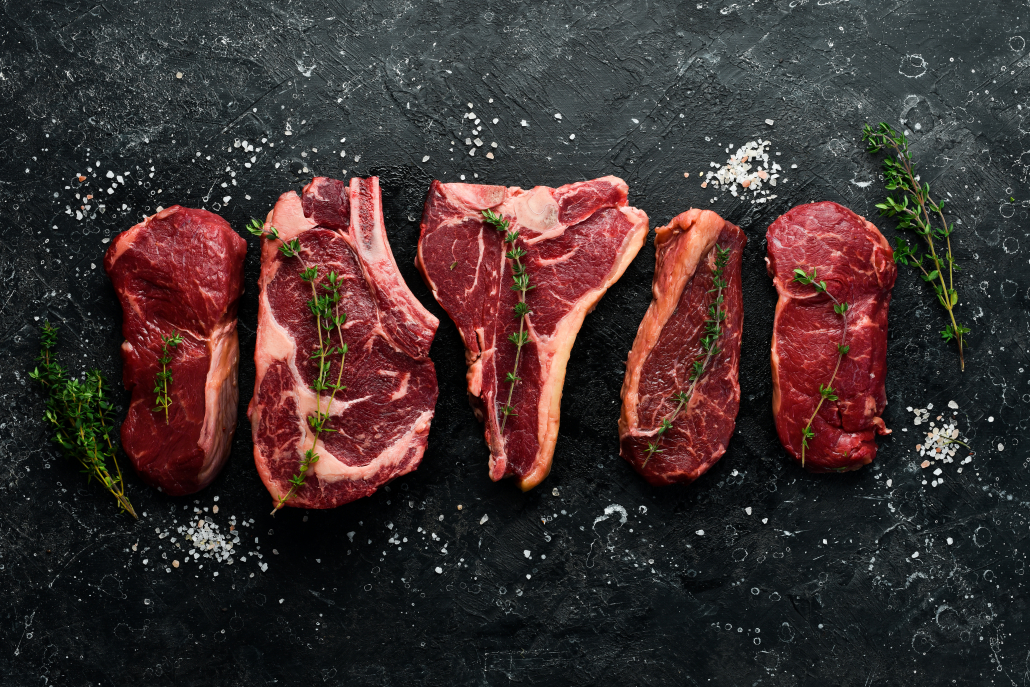
Lectins are one of numerous plant toxins and antinutrients that have only recently been explored for their possible negative health effects on humans. People seeking to avoid the possible negative health effects of lectins, are turning to lectin-free, and low-lectin foods.
Technically speaking, lectins are proteins that bind to carbohydrates. They’re found in every kind of living organism. But when it comes to lectins in our food, we get the vast majority from grains, legumes, and nightshade vegetables.
In this article, we’ll explore what lectins are, their drawbacks, and a list of lectin-free and low-lectin foods.
Fast Facts for Low Lectin Foods
- Lectins are sticky proteins that bind to carbohydrates
- Lectins can bind to the gut contributing to intestinal permeability known as “leaky gut”, arthritis, and chronic inflammation
- Common foods high in lectins include legumes, grains, nightshade vegetables, squash, A1 dairy, and to a lesser extent, conventionally raised meat
- The best low-lectin foods include grass-fed ruminant meats, along with fatty fish and seafood. To a lesser extent, there are numerous dairy and low-lectin vegetable options
Lectins in Plant Foods
Lectins are a key part of plant defense mechanisms. Their main protective role is to combat predation by pests–and humans are a big pest.
Lectins are found primarily in legumes and grains. You’ve most likely heard a lot about a particularly infamous lectin called gluten prevalent in our standard American diet loaded with wheat products.
Why Lectin-Free and Low Lectin Foods?
Due to various ethical, environmental, and misinformed nutritional beliefs, plant foods have been enthusiastically promoted by both popular and scientific cultures. Until recently, honest research into the possible detriments of plant foods has been largely suppressed.
However, emerging research suggests that a diet that eliminates lectins and focuses on low lectins foods may be beneficial for people with IBS, IBD, Chron’s disease, food sensitivities, and autoimmune disorders [1][2].
Dietary Evolution
Eliminating lectins is also supported by the idea that there is a discord between the foods humans evolved eating, and the engineered agricultural foods most of us eat now due to forces of economics, convenience, and dietary misinformation [3].
Significant research suggests that for nearly 2 million years our caveman ancestors evolved on a mostly carnivore diet.
The modern American diet, on the other hand, is comprised of 15% calories from grains, and 22% of calories come from added sugars [4]. Additionally, 20% of calories come from high-lectin vegetable oils. These three sources account for 57% of all calories.
Since we know that lectins bind to sugar, the combination of high-lectin high-carb grain and oils along with added sugars creates the opportunity for extreme lectin binding in joints, nerve junctions, and intestinal tissues, leading to a greater risk of chronic inflammation and autoimmune disorders [4][5].
Malnutrition
High lectin foods may contribute to malnutrition. This is due in large part to how they inhibit the absorption of numerous nutrients, including calcium, iron, zinc, and phosphorus [5].
Ironically, plant foods like legumes and grains are often lauded as sources of these same minerals. So the high lectins in these foods means that their true nutritional properties are much lower than portrayed by their labels [6].
Additionally, the polyunsaturated fats (PUFA) and phytic acid found in many plant foods can further inhibit digestive enzymes and bind to nutrients, further reducing nutrient availability [7][8][9].
Lectins and Leaky Gut
The binding property of lectins causes them to bond with the gut lining. This process damages the tight junctions of intestinal cells resulting in a condition known as intestinal permeability or leaky gut. Leaky gut is linked to chronic inflammation and numerous autoimmune disorders [10] [11].
Popular diet doctor Steven Gundry estimates that 90% of patients with autoimmune disorders show significant improvement after eliminating high-lectin foods and opting for low-lectin foods.
Furthermore, lectin binding to intestinal cells can disrupt intestinal flora growth and hormone signaling [12].
Aging
Since lectins bind to carbohydrates, they can attach to glucose and AGE molecules damaging internal tissue and causing signs of aging on the skin.
When lectins are consumed by people who have intestinal permeability, they can pass into the bloodstream and attach to glucose and AGEs in joints, between nerve junctions, and within myelin sheathes in a process known as glycation. Persistent glycation is associated with
chronic inflammatory issues, including diabetes and arthritis [13].
Inflammation
Researchers suggest that lectins may be the active compound in many inflammatory plant foods.
Studies have linked lectins to increases in inflammation associated with IBS and autoimmune conditions like rheumatoid arthritis [14].
People with IBS and leaky gut are also more susceptible to the negative effects of lectins, and their effects can be felt immediately.
Digestive Problems and Poisoning
Some lectins like phytohemagglutinin are highly poisonous. When ingested, they can irritate the intestines causing symptoms such as stomach pain, nausea, vomiting, and diarrhea [15].
Castor beans and several other plants contain an acutely poisonous lectin called ricin [16]. If you’ve watched Breaking Bad, you may remember when Walter White attempted to poison his enemies with Ricin.
Lectins in GMO Foods
Recall that lectins were originally evolved in plants for their protective properties. One of these lectins found naturally in rubber plants is called proheviein, which has powerful anti-fungal properties.
This has led biochemists to synthesize proheviein into genetically modified foods like tomatoes and potatoes. Now some experts are forecasting allergy outbreaks, especially in people with latex sensitivities [17].
In 1998, tests on lab rats fed GMO potatoes synthesized with insecticidal lectin genes, found that the animals suffered major damage to their immune systems, and vital organs including kidneys, spleens, and brains.
The study was conducted by Dr. Arpad Pusztai, a highly respected researcher for over 30 years. Though his findings were validated by more than 20 fellow scientists, he has been targeted with ridicule by purported experts funded by agricultural companies [18].
Low-Free Foods
Lectin-free foods also happen to be among the most nutrient-dense and healthiest foods in the world.
Since grass-fed ruminant meats offer the lowest lectin and highest nutrient combination, a carnivore diet food list is the foundation of a well-formulated low-lectin diet.
Low Lectin Animal Products
| FOOD | LECTIN CONTENT |
| Fish | Very low |
| Beef and other ruminant meats (especially grass-fed/pasture-raised) | Very low |
| Poultry | Very low |
| Eggs | Very low |
Low-Lectin Plant Foods
Some plant foods are lower in lectins than others. Sticking with low-carb fruits and keto-friendly vegetables is a good rule of thumb.
| FOOD | LECTIN CONTENT |
| APPLES | Low |
| ARUGULA | Low |
| AVOCADOES | Low |
| BEETS | Low |
| BLACKBERRIES | Low |
| BROCCOLI | Low |
| CABBAGE | Low |
| CARROTS | Low |
| CAULIFLOWER | Low |
| CHERRIES | Low |
| COLLARD GREENS | Low |
| KALE | Low |
| MIXED GREENS | Low |
| LEMONS | Low |
| LIMES | Low |
| MUSHROOMS | Low |
| ONIONS | Low |
| ORANGES | Low |
| RADISHES | Low |
| RASPBERRIES | Low |
| SCALLIONS | Low |
| STRAWBERRIES | Low |
| SWEET POTATOES | Low |
As you can see, many keto veggies are also low-lectin veggies.
Nuts
Some nuts are also low lectin foods. Yet many nuts are high in other plant toxins and antinutrients.
Eating too many nuts can lead to an overabundance of fiber that can contribute to the very problems that you seek to address by eating low lectin foods.
Nuts are also high in inflammatory omega-6 fatty acids–another reason to consume them in moderation [19].
| FOOD | LECTIN CONTENT |
| ALMONDS | Low |
| FLAX SEEDS | Low |
| HEMP SEEDS | Low |
| MACADAMIA NUTS | Low |
| PECANS | Low |
| PISTACHIOS | Low |
| PINE NUTS | Low |
| WALNUTS | Low |
Low-Lectin Fats
Healthy fats sourced from animals including tallow, ghee, coconut oil, and olive oil, are all low-lectin foods.
High-Lectin Foods to Avoid
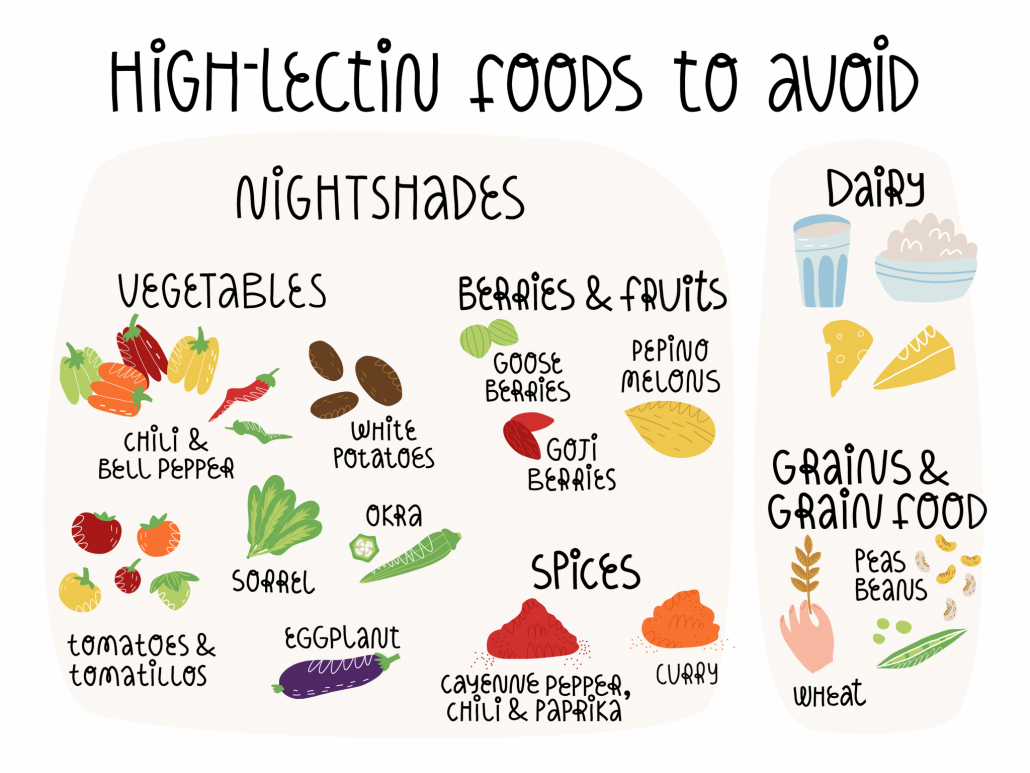
Low-Lectin Foods: The Bottomline
Lectins are proteins that bind to glucose molecules. Many popular plant foods contain lectins. Lectins in plants evolved to protect plants from predators and infection. When humans consume lectins, these molecules can bind to various body tissues contributing to leaky gut, glycation, chronic inflammation, and autoimmune disorders.
Focusing your diet on low-lectin foods, especially grass-fed meats, may reduce inflammation and allow the gut to heal. Low-lectin foods may be especially important for people with specific lectin sensitivities, IBS, Chrone’s disease, and arthritis.













